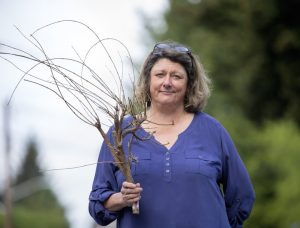I am finally able to talk about that snow storm, it gave me PTSD! Over 2 feet on my greenhouse brought it to the ground and did over $10,00.00 in damages to it....And then there are the Japanese Maples I've worked on for years that are now in Maple Tree Heaven with the Angels.
I am cabling all my Japaneses Maples that remain so next snow storm they will not break, there is special ropes we use to support the trunks and hold them together. The cabling or rope is flat and wide so it doesn't dig into the bark or wood, the rope can expand and stretch just enough to prevent damage but not hurt the tree. The cabling ropes are camouflaged and installed 2/3rds the way up, hardly noticeable but will save trees!
Tall wispy trees like White Birch that are bending all over the place look awful, however I believe they will straighten them selves out over the summer and it's almost impossible to cable those skinny, wispy top branches.
So I recommend that if the branches are not broken then leave them alone for the summer and we can all see if the are going to straighten up. If they don't straighten up then we can do some topping or pollarding to reshape them and get a new crown, pollarding them is the last thing to do but will save the tree and it will look a lot better.
Next time I hear it's going to snow I'll take it more seriously and protect my trees before the snow!!! I do expect it to happen again next winter, plants can be covered with tarps and trees can be tied up.
The snow was beautiful for a few hours then it was not, my wife and I live on a farm in the woods on top of a hill we were snowed in for a week, running the generator and eating our home canned foods, I knew my phone was going to be ringing of the hook as we used to say and it did...it was sad to see all the trees damaged it gets an Arborist right in the tree huger part!
Steve
 She was a friend and a great defender of plants.
She was a friend and a great defender of plants.